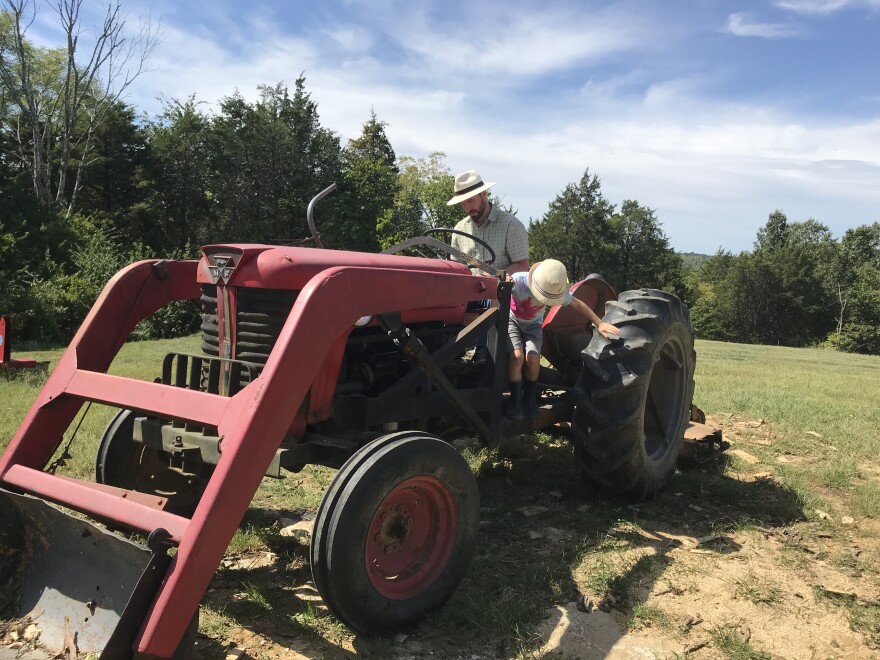In California, Kentucky at the top of a hill off a gravel road Mark McCafferty and his six-year-old son Anthony are riding on a big red tractor past the vegetable garden and the clothesline where clothes are flapping in the breeze. The father and son are moving large pieces of wood near a fire-ring in their front yard. (A solar panel attached to the tractor charges the battery. The tractor has a diesel engine.)
Mark and Emily McCafferty have known each other since they were five years old. They married in college and graduated from Morehead State University. Sustainable living has been a conscious way of life for the married couple since at least 2014.
“My mom kept saying, all my coworkers are asking for you to write about all that hippie stuff you do. And she was referencing at the time, you know, I was churning my own butter, making my own cleaners, we were cloth diapering, we used a real lawn mower instead of a gas or electric mower and people were curious about it,” said Emily.

So Emily started the blog, Accidental Hippies. The McCaffertys were not only living a simpler, environmentally friendly life but they had plans to build a cordwood solar-powered home. Emily says they had a hard time finding other people online who could offer them guidance. So they decided to become a resource for others.
On this sunny, Sunday afternoon Mark is giving a tour of their home where they generate clean energy from the sun.
The McCaffertys said, in their former house, their monthly utilities cost them approximately 260 dollars. Now their major utility expense is propane for a cost of about 45 dollars a month.
“So for all intents and purposes, we’re off the grid because we’re not connected to traditional utilities. We take our laundry and dry it on the laundry line and in the winter we don’t have a dryer because it’s too much power draw for the solar -system that we have. Our fridge is right behind us here. You still haven’t heard the compressor kick on because there’s no compressor. It’s actually run off of propane,” said Mark.
What started out as a way to be practical and save money has turned into an educational opportunity for people also interested in reducing their carbon footprint.
Emily writes the blog and Mark does lots of the research. Emily said, monthly there are 40,000 visitors to the blog. Between 30 and 40 people a month reach out to the couple for specific advice about building a solar- paneled home or something related to sustainability.

One man who’s building a solar- paneled home in Mt. Orab, Ohio found the blog and has been getting advice from the McCaffertys regularly. Thirty- six- year old Andy Watkins said he and his wife and their two children will live in the house they build.
“The McCaffertys have been an inspiration to us not only from the tools they provide via the blog to help us plan our own build. Just the way they carry themselves and their homestead and kind of building and forging their own path. I really like their simplistic approach to life and the things they’re doing out there as far as collecting the natural resources such as the water and the energy,”said Watkins.
Watkins has heard of sixteen- year- old Greta Thunberg, the Swedish activist who’s received international attention for inspiring worldwide climate strikes. He believes there’s a relationship to Thunberg’s work and people taking steps to live off the grid.
“I don’t know to what scale as far as what she’s trying to accomplish. But wherever you fall on either side of the coin it’s ultimately up to us to make small changes. I think small changes add up to large changes and ultimately big movements. And that’s what I want to instill in my household as well as what the McCaffertys are doing in theirs,” said Watkins
While the McCaffertys continue to assist people through the blog, Accidental Hippies, they are in the process of developing an online class about building solar-powered homes. Emily also wrote the e-book, The Owner-Builder Home Planner.
People like you value experienced, knowledgeable and award-winning journalism that covers meaningful stories in Central and Eastern Kentucky.
To support more stories and interviews like this one, please consider making a contribution






